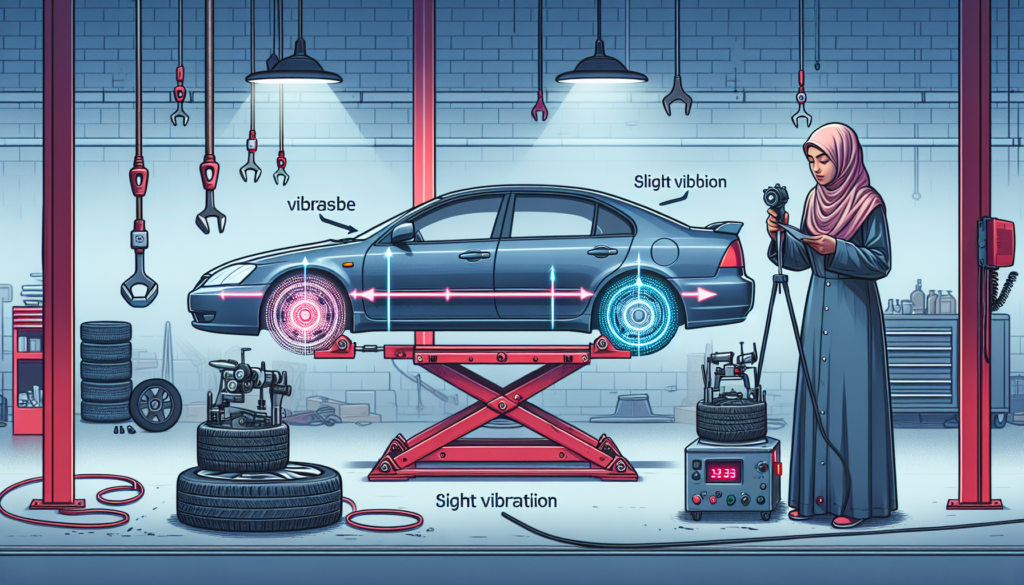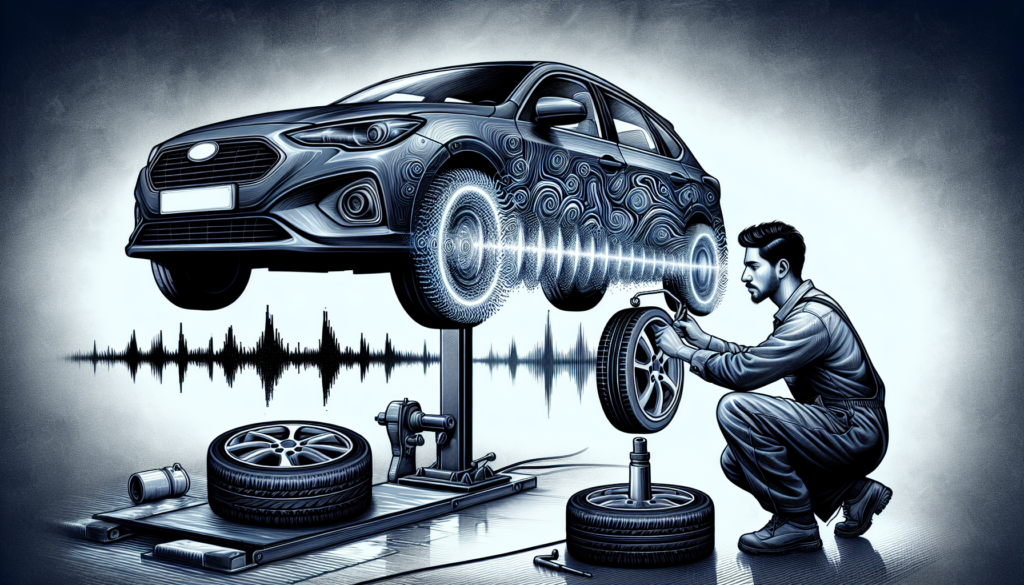Imagine driving down the road and feeling an annoying vibration that rattles your whole vehicle. Now, imagine if there was a simple solution to prevent those vibrations from occurring in the first place. That’s where wheel alignment comes in. In this article, we will explore the fascinating link between wheel alignment and vibrations while driving, and how this often overlooked maintenance task can provide a smoother and more comfortable driving experience. So buckle up and get ready to discover the secret to vibration-free driving!
What is Wheel Alignment?
Wheel alignment refers to the adjustment of the angles of the wheels in relation to each other and the vehicle’s body. This process ensures that the wheels are parallel to each other and perpendicular to the ground. Proper wheel alignment is crucial for a smooth and safe driving experience, as it prevents vibrations and uneven tire wear.
Causes of Vibrations While Driving
There are several factors that can cause vibrations while driving. These include uneven tire wear, wheel imbalance, axle problems, suspension issues, and misaligned wheels.
Uneven tire wear
Uneven tire wear can occur due to various reasons, such as improper inflation, worn-out suspension components, or misaligned wheels. When tires wear unevenly, it can create imbalances that lead to vibrations.
Wheel imbalance
Imbalanced wheels occur when the weight of the tire and wheel assembly is not evenly distributed. This imbalance can cause vibrations at high speeds, affecting the comfort and stability of the vehicle.
Axle problems
Issues with the vehicle’s axles, such as bent or damaged axles, can also result in vibrations. When the axles are not properly aligned, it can cause the wheels to wobble, leading to vibrations while driving.
Suspension issues
The suspension system of a vehicle plays a crucial role in ensuring a smooth ride. If any component of the suspension system, such as shocks, struts, or control arms, is worn or damaged, it can lead to vibrations and a bumpy driving experience.
Misaligned wheels
Misaligned wheels are one of the primary causes of vibrations while driving. When the wheels are not properly aligned, it can cause uneven tire wear, steering wheel vibrations, and a general sense of instability.

Understanding Vibrations
Vibrations while driving can vary in intensity and frequency. It is essential to understand the types of vibrations experienced and their effects on the driving experience and vehicle components.
Types of vibrations experienced while driving
Vibrations can be classified as vertical, lateral, or radial. Vertical vibrations are felt as an up and down motion, typically caused by imbalanced wheels or worn-out suspension components. Lateral vibrations are felt as a side-to-side motion and are often caused by misaligned wheels or axle problems. Radial vibrations are felt as an oscillating or pulsating sensation and can be caused by issues with tire balance or worn-out tire treads.
Effects of vibrations on driving experience and vehicle components
Vibrations can have various adverse effects. They can negatively impact the overall driving experience by creating discomfort and reducing vehicle stability. Additionally, vibrations can cause increased fatigue, leading to reduced driver alertness. Moreover, prolonged exposure to vibrations can result in premature wear and tear of various vehicle components, such as tires, suspension parts, and steering components.
How Wheel Alignment Prevents Vibrations
Proper wheel alignment plays a crucial role in preventing vibrations while driving. Here are some ways in which wheel alignment helps eliminate vibrations and improve the overall driving experience.
Proper tire contact with the road
Correct wheel alignment ensures that the tires make uniform and optimal contact with the road surface. When the wheels are properly aligned, it helps distribute the vehicle’s weight evenly across all tires, minimizing imbalances that can cause vibrations.
Reducing tire wear
Misaligned wheels can cause uneven tire wear, leading to imbalances and vibrations. Proper wheel alignment helps ensure that the tires wear evenly, extending their lifespan and preventing the development of vibrations.
Balancing wheel weight distribution
Imbalanced wheels can cause vibrations at high speeds. Wheel alignment involves balancing the weight distribution of the tire and wheel assembly, reducing imbalance and eliminating vibrations.
Preventing suspension and axle problems
Misaligned wheels can put additional stress on the suspension system and axles, leading to premature wear and potential damage. By ensuring proper wheel alignment, the load is distributed evenly, reducing the strain and preventing suspension and axle problems that can cause vibrations.
Enhancing overall driving experience
Proper wheel alignment results in a more comfortable and stable driving experience. Eliminating vibrations not only improves comfort but also enhances vehicle handling and control, ensuring a safer and more enjoyable drive.

Benefits of Proper Wheel Alignment
Proper wheel alignment offers several benefits beyond preventing vibrations while driving. Let’s explore some of these benefits:
Improved vehicle stability
Properly aligned wheels provide better stability and control, especially during cornering and emergency maneuvers. This enhanced stability can contribute to a safer driving experience and reduce the risk of accidents.
Enhanced fuel efficiency
When the wheels are aligned correctly, there is reduced rolling resistance, resulting in improved fuel efficiency. Proper wheel alignment ensures that the tires roll smoothly, reducing the effort required from the engine and maximizing fuel economy.
Extended tire lifespan
Uneven tire wear caused by misaligned wheels can significantly reduce tire lifespan. By ensuring proper wheel alignment, tires wear evenly, resulting in extended tire life and cost savings in the long run.
Reduced wear on suspension components
Misaligned wheels can put additional stress on suspension components, causing premature wear and potential damage. Proper wheel alignment reduces the strain on suspension parts, leading to less wear and a longer lifespan for these critical components.
Enhanced safety
Proper wheel alignment is essential for safe driving. It improves vehicle stability, reduces the risk of accidents, and ensures optimal tire performance. By eliminating vibrations and improving handling, proper wheel alignment enhances overall driving safety.
Signs of Misaligned Wheels
It is essential to recognize the signs of misaligned wheels to address the issue promptly. Here are some common signs to watch out for:
Vehicle pulling to one side
If your vehicle tends to drift or pull to one side while driving straight, it could indicate misaligned wheels. This pulling can be subtle or more pronounced, depending on the severity of the misalignment.
Uneven tire wear
Misaligned wheels can cause uneven tire wear. Inspect your tires regularly and look for signs of excessive wear on one side or in certain areas. Uneven wear patterns can indicate the need for wheel alignment.
Steering wheel vibration
If you experience vibrations in the steering wheel while driving, especially at higher speeds, it could be a sign of misaligned wheels. Vibrations can be felt as a subtle trembling or more noticeable shaking of the steering wheel.
Off-center steering wheel
Park your vehicle on level ground and observe the position of the steering wheel. If it is not centered when the wheels are straight, it may suggest misaligned wheels.

How to Check Wheel Alignment
Checking wheel alignment is best done by a professional. Specialist equipment and expertise are required to accurately measure and adjust the alignment angles. However, there are some DIY methods that can provide an initial assessment.
Professional wheel alignment services
To ensure accurate and precise wheel alignment, it is recommended to visit a professional auto service center. They have specialized equipment to measure and adjust the alignment angles, ensuring optimal results.
DIY methods for initial assessment
While not a substitute for professional alignment, there are a few simple checks you can perform to get a rough idea of your vehicle’s wheel alignment. Visual inspection of tire wear patterns, checking for steering wheel centeredness, and observing any signs of vehicle pulling can provide initial indicators of misalignment.
When to Get Wheel Alignment
There are specific situations and signs that indicate the need for wheel alignment. Here are some instances when you should consider getting your wheels aligned:
After hitting a curb or pothole
If you’ve hit a curb or a deep pothole, it can cause misalignment. The impact can knock the wheels out of alignment, leading to vibrations and potentially uneven tire wear. In such cases, it is important to get the wheels checked and realigned.
When experiencing signs of misaligned wheels
If you notice any of the signs mentioned earlier, such as vehicle pulling, uneven tire wear, steering wheel vibration, or an off-center steering wheel, it is a good indication that your wheels may be misaligned. Getting a wheel alignment check in such situations is essential.
As part of regular maintenance
Including wheel alignment as part of your regular vehicle maintenance routine is a proactive approach. Even without any noticeable signs of misalignment, it is recommended to get your wheels aligned periodically to ensure optimal performance and prevent potential issues.

Wheel Alignment Procedure
The wheel alignment procedure involves a comprehensive inspection, measurement, and adjustment. Here’s a general overview of the process:
Inspection and measurement
During the inspection phase, a qualified technician will examine the vehicle’s suspension components, tires, and steering system for any signs of wear or damage. Specialized tools and equipment, such as alignment racks and laser alignment systems, are used to measure the alignment angles of the wheels accurately.
Adjustment and correction techniques
Based on the measurement results, the technician will make the necessary adjustments to bring the wheels into proper alignment. This involves adjusting the camber, caster, and toe angles to meet the manufacturer’s specifications. Different adjustment techniques, such as replacing worn suspension components, tightening or loosening specific bolts, and adjusting the steering linkage, may be employed.
Conclusion
Proper wheel alignment is essential in preventing vibrations while driving. Misaligned wheels can cause uneven tire wear, imbalances, and various other issues that can result in vibrations and a compromised driving experience. Regular wheel alignment as part of your vehicle maintenance routine helps ensure optimal tire performance, extended lifespan, improved fuel efficiency, and enhanced safety. Remember to pay attention to signs of misaligned wheels, and consult a professional for accurate measurement and adjustment. By prioritizing wheel alignment, you can enjoy a smoother, more comfortable, and safer driving experience.


